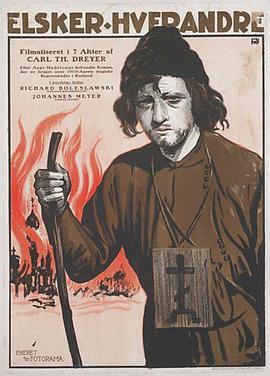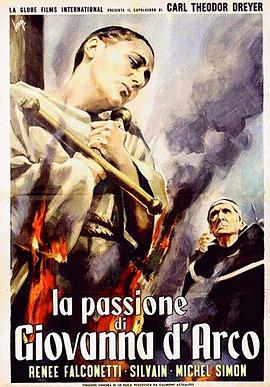-
备注:已完结
类型:剧情片
导演:卡尔·西奥多·德莱叶
语言:其它
年代:未知
简介:英俊青年麦克尔(Walter Slezak 饰)是画家苏莱特的专属模特,以麦克尔为原型,苏莱特创作出了精美的艺术作品,名声大噪,登门求画的人络绎不绝,但苏莱特为了保存和麦克尔的美好回忆拒绝出卖杰作。年轻貌美的女伯爵拜访苏莱特,请求后者为自己画像,麦克尔默默注视着女伯爵,四目交投之下,情意暗生,苏莱特思量之后决定为女伯爵作画,但创作不久因苏莱特无法描画女伯爵的眼睛而陷入停滞,麦克尔提笔代劳,女伯爵美丽的神色跃然画上……麦克尔与女伯爵相爱并逐渐离苏莱特而去,苏莱特承受着年青人的欺骗和背叛,将内心的悲苦呈现在画作上,受孤独煎熬的生命之火渐渐熄灭…… 本片根据赫曼·邦的同名小说改编,是电影史上最早涉及同性恋题材的作品之一。
-
备注:已完结
类型:剧情片
主演:Adele Reuter-Eichberg 弗拉基米尔·盖达罗夫 Po
导演:卡尔·西奥多·德莱叶
语言:其它
年代:未知
简介:Russie, 1905. Lasse de l'atmosphère antisémite de son village natal, la jeune Hanne Segal part à Saint-Pétersbourg rejoindre son frère Jacob qui, converti au christianisme, est devenu un riche avocat. Elle y retrouve aussi son ancien ami Sacha, entré dans un groupe révolutionnaire...
-
备注:已完结
类型:剧情片
主演:尼娜·彭斯·罗德 本特·罗斯 埃贝·罗德 巴尔德·奥维 阿克塞尔·斯特
导演:卡尔·西奥多·德莱叶
语言:丹麦语
年代:未知
简介:本片讲述了一个周旋于几个男人间的女人的爱情故事。女歌手Gertrud(Nina Pens Rode 饰)的丈夫Gustav Kanning(Bendt Rothe 饰)将成为内阁大臣,Gertrud却向丈夫坦诚她不再爱他了,因为他把工作看得太重要而忽略了对她的爱。Gustav问她是否有了新欢,她承认了。之后她离开家去见了她的爱人,年轻的音乐家Erland Jansson,两人互诉衷肠,Gertrud仿佛可以看到两人的美好未来。第二天,大诗人Gabriel Lidman(Ebbe Rode 饰)的欢迎宴会上,Gertrud也出席了。原来她和Lidman也有过一段感情。Lidman想要挽回Gertrud,被她拒绝了。Lidman告诉她,他知道Erland其实爱的是另外一个人。于是当Erland弹奏着钢琴,Gertrud唱着歌的时候,她晕了过去。Getru...
-
备注:已完结
类型:剧情片
主演:玛利亚·法奥康涅蒂 安德烈·贝利 莫里斯·舒茨 安托南·阿尔托 米歇尔
导演:卡尔·西奥多·德莱叶
语言:法语
年代:未知
简介:影片聚焦法国民族女英雄圣女贞德(玛利亚·法奥康涅蒂 Maria Falconetti饰)生命的最后时刻,再现了她被出卖落入勃艮第叛军手中后,在英格兰监狱和法庭上,从受审到处死的全过程。被英格兰当局严密控制的天主教会,指控贞德为异端和女巫。法庭上,法官更伪造证据,以信仰问题不断对她施以精神上和肉体上的折磨。面对惨无人道的酷刑与子虚乌有的诬陷,贞德正气凛然、坚贞不屈。最后,贞德被押赴鲁昂市广场,被绑在火刑柱上活活烧死。 由一代电影大师卡尔·西奥多·德莱叶执导拍摄的影片《圣女贞德蒙难记》,被称为世界十大最佳影片之一。影片以极具震撼力的艺术表现手法,再现了这段受到天主教会和英国占领军折磨的民族英雄短暂生命中的最后时刻。
-
备注:已完结
类型:剧情片
主演:Ib Koch-Olsen
导演:卡尔·西奥多·德莱叶
语言:其它
年代:未知
简介:The history of Danish country church architecture is told by showing scenes of how the church was used by the congregation, beginning with the celebration of mass in a small and simple wooden church 800 years ago, and ending with the congregation singing in a village church of to-day. The development and the growth of the pattern of church architecture is shown. Dreyer in this film shows a series of churches from different periods with churchgoers in period clothing. Each period is separated by a shot of a church bell double-exposed on the sky. Although the film has a vibrant and instructive way of communicating the different epochs and styles to students, it does not exhibit the artistic quality that usually distinguishes a Dreyer film, except perhaps in some of the costumes, which were originally made for Day of Wrath. The board of Dansk Kulturfilm in autumn 1945 decided that their planned church film would exclusively be about village churches. Dreyer would rework the script that was written by editor and folk high-school principal Bernhard Jensen, aided by a committee of experts consisting of architect H. Lønborg-Jensen and Victor Hermansen, curator at the National Museum of Denmark. Dreyer had a first draft ready in mid-March, entitled Kirken er et gammelt Hus (The Church Is an Old House), which was distributed to the members of the committee for their comments. In the last half of July, Dreyer and Victor Hermansen travelled the country to look at suitable churches. They researched the details and at Dreyer’s request a number of technical changes were made to the churches, including the removal of porcelain holders for electrical wiring in Tveje Merløse Church. On 4 July, Dreyer went in advance to Ringkøbing. Shooting was set to start a few days later with the arrival of the director of photography, Preben Frank, who had fallen off a ladder and broken his leg, Fortunately, he was ready to cautiously start working again within a few days, with his leg in a cast. Otherwise, the production went without a glitch. Everywhere, Dreyer said, they were well received at the vicarages and they had no problem getting enough extras. On 1 august, they returned to Copenhagen with almost all their footage in the can. They only needed to film the church in Skelby, where the weather had been against them, plus a Swedish wooden church in Hedared. The economy was distressed so soon after the war, especially when it came to foreign currency, but there were no real wooden churches left in Denmark and building an interior set in the studio would be too expensive. The finished film was shown for the first time on 24 September 1947 to a small, closed circle, which included the Minister for Ecclesiastical Affairs. In December 1947, as was Dansk Kulturfilm’s standard practice, the film was presented to the press, politicians and others on a programme with four other short films.









